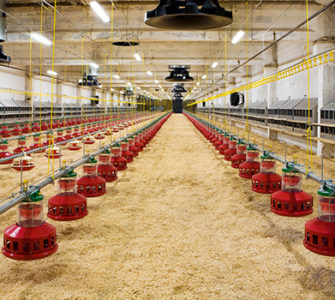Nearly 60% of US broilers now raised without antibiotics, but that number may have peaked
Almost six in 10 US broilers were raised without antibiotics of any type in 2019 — but that number may have peaked, according to Greg Rennier, PhD, president of Rennier Associates Inc., a company that tracks poultry-health markets in the US.
Broilers raised in no antibiotics ever (NAE) systems accounted for 58% of total US production last year, a 7-point increase over the previous 12 months (Figure 1).
Increases in NAE systems in recent years have primarily come at the expense of “full-spectrum” programs that allowed the use of antibiotics deemed to be medically important.
But since full-spectrum usage has become almost non-existent, further growth of NAE production is unlikely.
Leveling off
“We’ve arrived to the point where we might expect less change in the next couple of years, primarily because full-spectrum production is essentially down to zero,” Rennier told Poultry Health Today.
“Especially in the last couple of years, most of the growth in NAE was coming from the full-spectrum part of the business.”
Rennier said reduced-use poultry programs — those that allow the use of non-medically important antibiotics — have held steady the past 2 years at about 25% of production, suggesting that NAE production is unlikely to pull any additional share from that moderate category.
A fourth group that Rennier calls “ionophores only” has hovered between 15% and 18% over the past 3 years. That suggests there will always be producers who continue to use animal-only antibiotics to prevent ubiquitous challenges such as coccidiosis.
“I think we’re down to a group of producers who are not going to go to NAE,” he added. “For various reasons, they continue to use and rely upon non-medically important antibiotics like bacitracin, avilamycin and ionophores.
“These producers have weathered the NAE storm when everyone else was changing, and they held to a more traditional style of management that best fit their systems and their clients. I just don’t see any indication they are going to, or need to, change.”
Changes in the hatchery
One of the other notable trends in this year’s survey is the number of broiler chicks receiving an antibiotic in the hatchery during in ovo vaccination. That practice has fallen to almost zero, Rennier said.
“Only 6 or 7 years ago, about nine out of 10 broilers were being administered an antibiotic in the hatchery,” he added.
“So, not only do we have NAE going up, we’re seeing the use of antibiotics in the hatcheries just falling off to nothing.”
To manage the health implications of this reduction, Rennier said producers were focusing more on sanitation in the hatchery.
“Antibiotics covered small issues and took care of them,” he said. “Not that good sanitation wasn’t a priority in the past, but they are really making sure the hatchery is clean so there aren’t any problems antibiotics need to fix.”
New approaches to coccidiosis
As producers eliminate antibiotics from their production systems, a large number are turning to non-ionophore anticoccidials (NIA) to help prevent coccidiosis, Rennier said.
Almost 50% of the feed tonnage contained an NIA last year, up from just 19% in 2015. Meanwhile, feed containing ionophores, a class of antibiotics for coccidiosis prevention, almost halved from 2015 levels (27% in 2019).
Rennier also found that most NAE programs employed eubiotics — products that provide a healthy balance of the microflora in the gastrointestinal tract — whether that was a microbial, botanical, yeast, essential acid or combination.
Rennier pointed out that producers in the past had used a “kitchen sink” approach in which they tested and evaluated multiple eubiotics. He noted that many integrators had now settled on a few products, resulting in more consistent programs.
“Production and technical managers seemed to have settled on set programs. Some had a summer versus winter program, whereas others seemed to use different products when on coccidiosis vaccines,” he said.
“It appears that after 4 or 5 years of tackling these issues, trying different products and evaluating the results, integrators were starting to get into a groove with what they were doing — they were down to the one, two or three products they thought worked best for them.”
Outlook for 2020
Looking ahead to next year’s survey, Rennier said he didn’t expect to see any major changes in the numbers, provided the products available to producers continue to work as they have done.
“Obviously, we might get to a point where the non-ionophore anticoccidials could become a little less effective as we use them more, but there’s no indication we’re there yet,” he said.
“And I think people are now comfortable with how they’re raising birds. I don’t see anyone that stopped using antibiotics going back anytime soon.”
The future for ionophores is a little more difficult to predict, however.
“As long as things are going the way they are now, I think ionophores have a place, and I think they will rebound at some point in the future. It’s just difficult to say when we’ll reach that point.” he said.
“We have a limited number of products, and once we use one category, we need to switch to another.
“I’m guessing in 3, 4, 5 years you’ll start to see ionophores creep up a little, but they’ll probably never go back to what they were.”
For all the innovations and products associated with coccidiosis management in broiler chickens, producers in Rennier’s survey still ranked coccidiosis as the top disease of poultry, up from the second spot over the previous 3 years.
Conversely, necrotic enteritis — a disease long associated with shortfalls in coccidiosis control — was ranked No. 3 in 2019, down from the top position in 2018.
Posted on May 4, 2020


















